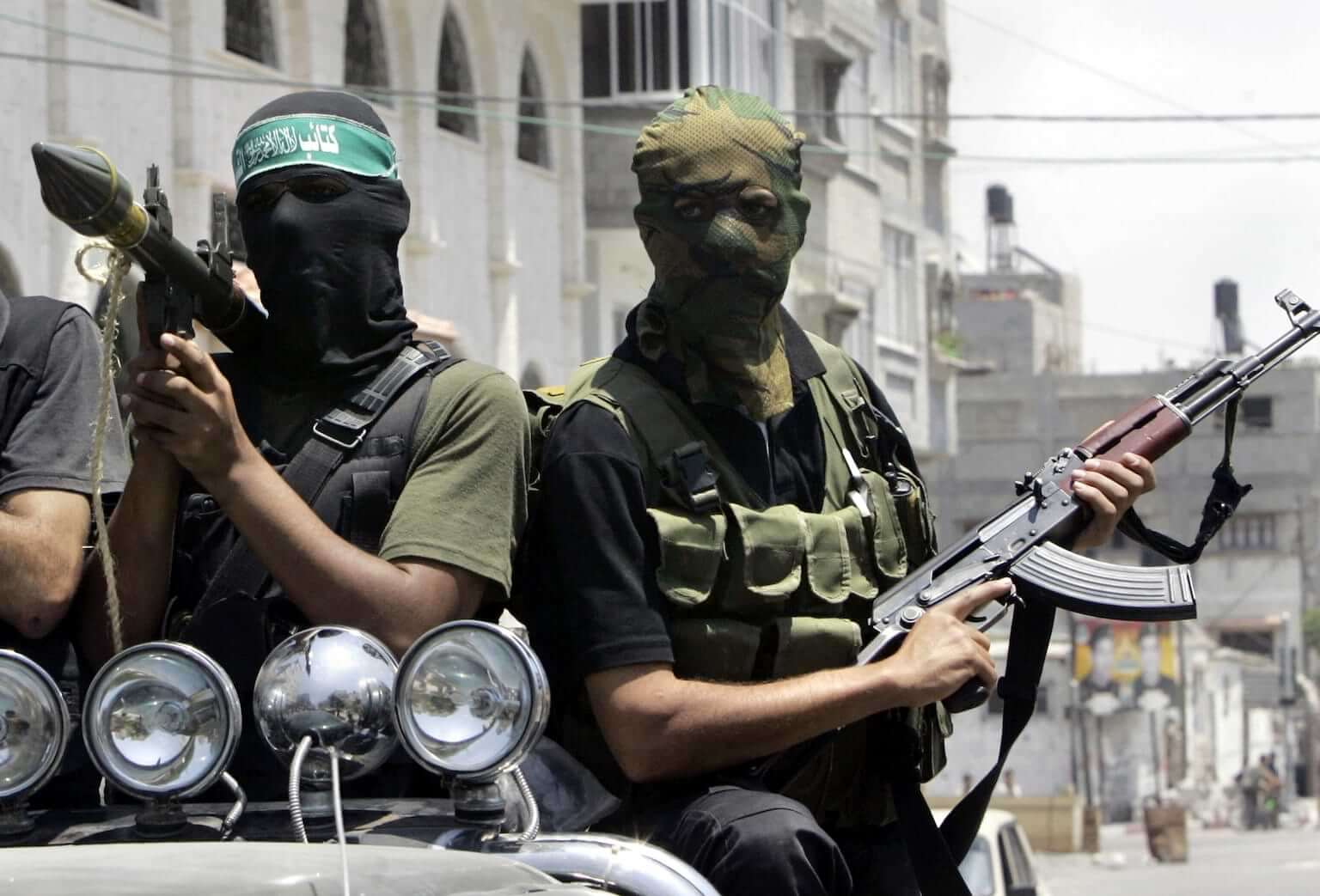
FILE - Palestinian militants from Hamas ride on a truck with their weapons during the funeral of militant Emad Abu Kados who was killed during clashes with Fatah gunmen in the Sheikh Radwan neighborhood in Gaza City, June 13, 2007. (AP Photo/Hatem Moussa, File)
A word of warning: This article includes graphic descriptions of terrorist acts.
“Babies, women, the elderly were dragged outside of their homes, were taken hostage. Civilians were shot and most were massacred in cold blood walking on the streets. This is something that, I mean, is truly unprecedented.” This is how Israeli Ambassador to the UN Gilad Erdan described the surprise attack Hamas launched on Israel by air, land, and sea on October 7, 2023.
“This is our 9/11,” he added.
A spokesman for the Israeli Defense Forces said, “We have had the worst day in Israeli history when it comes to casualties. . . . In American terms, this is a Pearl Harbor and a 9/11 all together.”
After the invasion by Hamas’s terrorists, forensic teams were dispatched to document their atrocities. A reserve officer serving with these observers said, “We’ve seen dismembered bodies with their arms and feet chopped off, people that were beheaded, a child that was beheaded.” Multiple cases of rape were found by examination of the bodies.
A physician who is also an observant Muslim arrived on the scene on October 19 to spend ten days as a human rights observer. She reported: “One word continually came to mind: genocide. No matter how it emerges, the monster is easy to recognize. As a doctor, I had a rare and panoramic view of the aftermath: the targeted people’s long, agonizing journey to death.” She noted, “Hamas tortured and immolated its victims, including children, pregnant women, and the unborn.”
Why does Hamas hate Israel? Why did it commit such atrocities? What does it hope to gain?
Let’s survey the pertinent questions behind the worst civilian attack in the modern history of Israel, then close by discussing the existential nature of this crisis for Israel and identifying practical and redemptive ways we can respond.
NOTE: This resource article belongs to a series regarding the foundational issues behind the ongoing war between Israel and Hamas. The full series is also available as a free ebook.
What is Hamas?
As we noted in Chapter 1, the areas of Palestinian occupation in the Middle East are called the “West Bank” and the “Gaza Strip.” The West Bank is governed by Fatah, an acronym for “Palestinian National Liberation Movement.” This political party was founded in 1959 by Yasser Arafat, who led the group until his death in 2004.
The Gaza Strip is governed by Hamas (“fervor”), which is an acronym (spelled backward) for “Islamic Resistance Movement.” The group’s origins go back to Sheikh Ahmed Yassin, who began his movement in the late 1960s as an offshoot of the Muslim Brotherhood. In 1973, he established the “Islamic Center” to coordinate the Brotherhood’s activities in Gaza and founded Hamas as their political arm in 1987. Hamas published its official charter in 1988, calling for the destruction of Israel and raising “the banner of Allah over every inch of Palestine.”
For much of the group’s history, the military wing of Hamas called the Izz al-Din al-Qassam Brigade has sponsored terrorism against Israel. It has repeatedly launched rocket attacks at Israeli towns and sponsored a series of suicide bombers before Israel constructed a “security fence” around its borders.
The group operated as an opposition party in Gaza until winning parliamentary elections in 2006 and ousting Fatah from the area the next year. Since that time it has been in conflict with Fatah, which still governs the West Bank, so that the Palestinian people have had no unified government or advocate.
Here are some snapshots of life in Gaza under Hamas:
- Only 3 percent of the population lives to be sixty-five years of age.
- Less than 10 percent of the water is fit to drink.
- Electricity is available for only about four hours a day.
- Three out of ten people live below the $1.90-a-day poverty line.
- Eighty percent depend on charity for food.
Hamas called its October 7 attack on Israel “Operation Al-Aqsa Deluge” and claimed it was acting in retaliation for Israel’s “desecration” of the Temple Mount, but we should look beyond its words to its foundational beliefs.
What happened on October 7?
According to Reuters, a “careful campaign of deception” enabled “the worst breach in Israel’s defenses since Arab armies waged war in 1973.” The attack followed two years of subterfuge that kept Hamas’s military plans under wraps while convincing Israel it did not want a conflict. According to a source near Hamas, Israel was led to believe it was containing Hamas by providing economic incentives to Gazan workers. All the while, the group’s fighters were being trained and drilled, often in plain sight.
For example, Hamas constructed a mock Israeli settlement in Gaza where they practiced a military landing and trained their soldiers to storm it. They even made videos of their maneuvers. At the same time, they convinced Israel that they were more concerned about ensuring Gaza workers had access to jobs across the border.
An Israeli army spokesman said, “They caused us to think they wanted money. And all the time they were involved in exercises/drills until they ran riot.”
Hamas also refrained from military operations against Israel when Palestinian Islamic Jihad (PIJ), another Gaza-based Islamist armed group (to be discussed in Chapter 6), launched its own assaults or rocket attacks. They apparently used couriers to communicate rather than modern devices to avoid detection. And they were aware of Israel’s ability to infiltrate and monitor Islamist groups, so many Hamas leaders were left unaware of the plans. While training, the fighters deployed in the assault had no inkling of the exact purpose of the exercises.
This while Israel was turning its attention to normalizing relations with Saudi Arabia and dealing with mass demonstrations over proposed judicial reforms. Israeli troops were well below full strength in the south near Gaza since some had been redeployed in the West Bank to protect Jewish settlers following a surge there with Palestinian militants. The Wall Street Journal later reported that this escalation appears to have been a calculated move to distract attention from the planning in Gaza. Hamas exploited this distraction and timed its attack to coincide with the Jewish Sabbath and a major religious holiday.
It sent a barrage of three thousand rockets from Gaza coordinated with incursions by fighters who flew hang gliders over the border. These fighters secured the terrain so an elite commando unit could storm the fortified electronic and cement wall Israel had built to prevent infiltration. The fighters used explosives to breach the barriers, then they sped across on motorbikes. Bulldozers then widened the gaps so more fighters could enter in four-wheel drives.
The result was what a former national security advisor to Prime Minister Netanyahu called “a huge failure of the intelligence system and the military apparatus in the south.”
Around three thousand terrorists invaded southern Israel in an unprecedented assault on Jewish civilians. They were believed to have killed around fourteen hundred people, but Israel later revised downward the death toll to approximately twelve hundred after unidentified corpses previously included in the total were identified as Hamas terrorists.
They attacked a music festival and kibbutz residents, killed people hiding in bomb shelters and in their homes, and seized at least 245 hostages.
US Secretary of State Antony Blinken later described what authorities found in one home attacked by the terrorists: “A family of four. A young boy and girl, six and eight years old, and their parents around the breakfast table. The father’s eye gouged out in front of his kids. The mother’s breast cut off, the girl’s foot amputated, the boy’s fingers cut off—before they were executed. And then their executioners sat down and had a meal. That is what this society is dealing with.”
Why did Hamas attack Israel?
Hamas has been in conflict with Israel since seizing control of Gaza. Its goal is more than aggression against Jews, however.
As we noted in Chapter 4, Hamas is part of a movement of radical jihadists who claim that the State of Israel stole its land from its rightful Muslim owners. They believe the Qur’an requires them to defend Islam by attacking Israel and anyone who supports the Jewish people (cf. 2:190; 9:5). Since Israel is a democracy, they view its Jewish citizens to be complicit in this “attack” on Islam.
Hamas published its official charter in 1988, calling for the destruction of Israel and raising “the banner of Allah over every inch of Palestine.” Its founder, Sheikh Ahmed Yassin, stated that “reconciliation with the Jews is a crime” and claimed that Israel “must disappear from the map.”
To accomplish this goal, Hamas needs to do three things.
One: Prevent Muslim nations from supporting Israel.
The Abraham Accords brought the United Arab Emirates and Bahrain into normalized relations with Israel in 2020. More recently, Saudi Arabia has been considering steps to normalize relations with Israel in exchange for a defense pact with the US.
The October 7 attacks were clearly intended to sabotage such talks. They apparently achieved their goal, at least in the short term, when the Saudi government issued a statement blaming the conflict on “the deprivation of the Palestinian people of their legitimate rights.”
Two: Provoke a response that draws other Muslims into the conflict.
Hamas says its attacks are only the beginning and stated, “It is possible that the battle would involve regional parties.” How could this happen?
By committing horrific atrocities, including taking dozens of hostages, Hamas is inciting a response it can characterize as an attack on all Palestinians and Muslims. Since the Qur’an requires Muslims to defend Muslims (4:75; 22:39), Hamas apparently hopes other Muslims in the region will then join its war on Israel.
This could include Hezbollah, a heavily armed militant group controlling southern Lebanon (to be discussed in Chapter 6). They briefly exchanged artillery and missile fire with Israel after the invasion and have continued to engage in limited attacks. The Popular Front for the Liberation of Palestine in the north and Palestinian Islamic Jihad in Gaza and the West Bank are other jihadist groups that could join the conflict.
A former Israeli security advisor warned that Israel will face an “existential threat” if Hezbollah, Iranian militias in Iraq and Syria, and Palestinian terrorists in the West Bank join the fighting. It will be crucial to see if the conflict with Israel expands beyond Hamas.
Three: Engage other nations in the widening conflict.
Senior Hamas and Hezbollah members said Iranian security officials helped plan the attack on Israel and gave it the green light. According to the Wall Street Journal, these officials described their broader plan to create the multi-front threat described above.
Many Iranian leaders believe the Mahdi (the Twelfth Imam, their version of a Messiah) will appear to govern the world for Islam after the Muslim world destroys the Jewish state (to be discussed in Chapter 6). Some believe that this war with Israel will occur after a world war, viewing Russia’s invasion of Ukraine as this necessary prelude.












